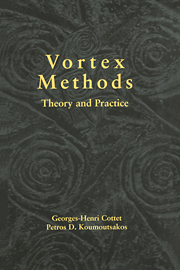Book contents
- Frontmatter
- Contents
- Preface
- 1 Definitions and Governing Equations
- 2 Vortex Methods for Two-Dimensional Flows
- 3 Three-Dimensional Vortex Methods for Inviscid Flows
- 4 Inviscid Boundary Conditions
- 5 Viscous Vortex Methods
- 6 Vorticity Boundary Conditions for the Navier–Stokes Equations
- 7 Lagrangian Grid Distortions: Problems and Solutions
- 8 Hybrid Methods
- Appendix A Mathematical Tools for the Numerical Analysis of Vortex Methods
- Appendix B Fast Multipole Methods for Three-Dimensional N-Body Problems
- Bibliography
- Index
7 - Lagrangian Grid Distortions: Problems and Solutions
Published online by Cambridge University Press: 21 September 2009
- Frontmatter
- Contents
- Preface
- 1 Definitions and Governing Equations
- 2 Vortex Methods for Two-Dimensional Flows
- 3 Three-Dimensional Vortex Methods for Inviscid Flows
- 4 Inviscid Boundary Conditions
- 5 Viscous Vortex Methods
- 6 Vorticity Boundary Conditions for the Navier–Stokes Equations
- 7 Lagrangian Grid Distortions: Problems and Solutions
- 8 Hybrid Methods
- Appendix A Mathematical Tools for the Numerical Analysis of Vortex Methods
- Appendix B Fast Multipole Methods for Three-Dimensional N-Body Problems
- Bibliography
- Index
Summary
In vortex methods the flow field is recovered at every location of the domain when one considers the collective behavior of all computational elements. The length scales of the flow quantities that are been resolved are characterized by the particle core rather than the interparticle distance. These observations, which stem from the definition itself of vortex methods and are confirmed by its numerical analysis, differentiate particle methods from schemes such as finite differences.
The essense of the method is the “communication” of information between the particles, that requires a particle overlap. As a result, a computation is bound to become inaccurate once the particles cease to overlap. Computations involving nonoverlapping finite core particles should be regarded then as modeling and not as direct numerical simulations. Excluding case-specific initial particle distributions (e.g., particles placed on concentric rings to represent an azimuthally invariant vorticity distribution) the loss of overlap (and excessive overlap) is an inherent problem of purely Lagrangian methods.
The cause of the problem is the flow strain that may cluster particles in one direction and spread them in another in the neighborhood of hyperbolic points of the flow map, resulting in nonuniform distributions. At the onset of such particle distributions no error is usually manifested in the global quantities of the flow such as the linear and the angular impulse. However, locally the vorticity field becomes distorted and spreading of the particles results in loss of naturally present vortical structures, whereas particle clustering results in the appearance of unphysical ones on the scale of the interparticle separation.
Information
- Type
- Chapter
- Information
- Vortex MethodsTheory and Practice, pp. 206 - 236Publisher: Cambridge University PressPrint publication year: 2000
